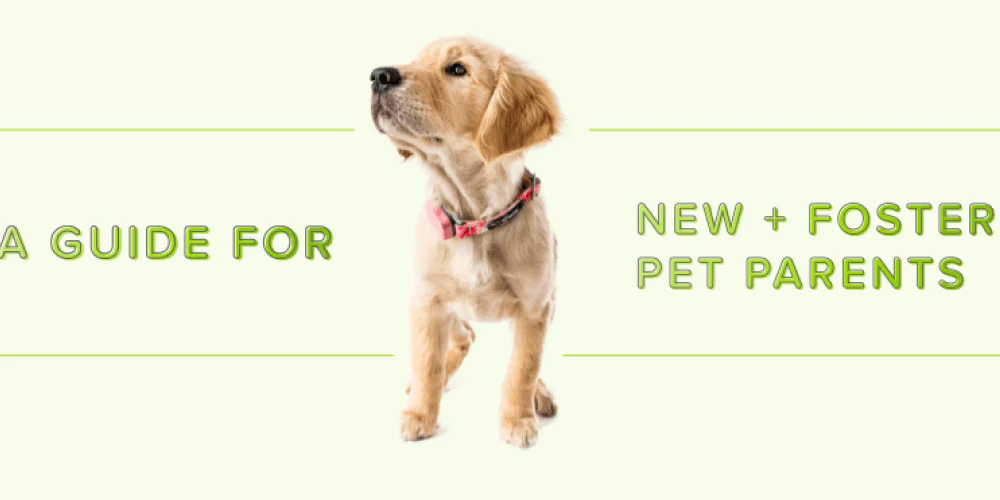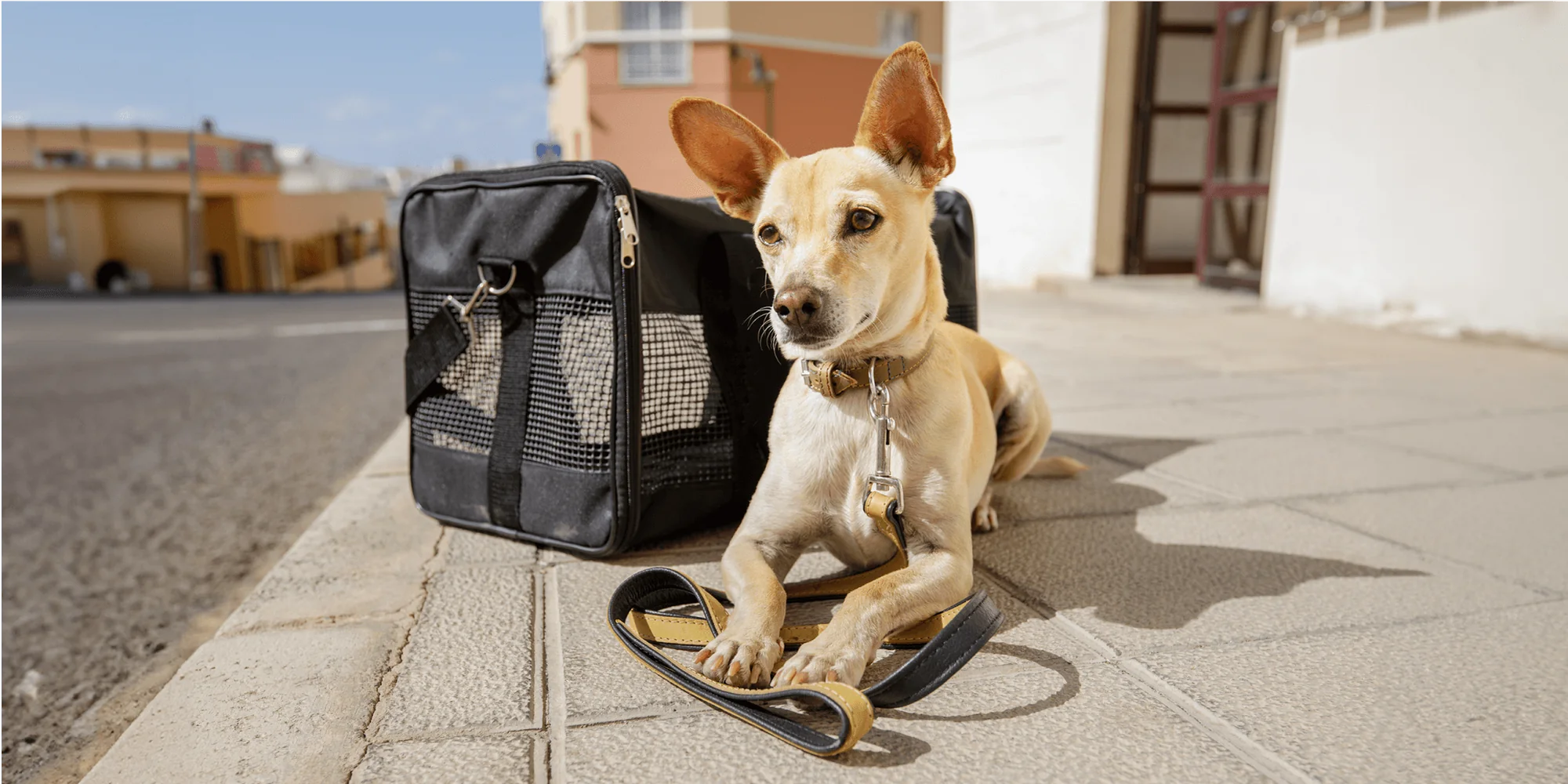A guide for new & foster pet parents

Shelters across the country are looking for people to help foster a dog and provide them a loving home during this time. As foster parents, and puppy & dog owners ourselves, we wanted to offer a little insight into how best to care for your pup based on their breed and required activity levels.
In partnership with Banfield Pet Hospital and Wisdom Health, here are some quick tips from the experts:

1. Prepare for A New Pet or Foster
Before you bring a new dog into your home, it’s important to carefully consider what kind of dog will be right for your home environment and lifestyle. Here’s how:
Assess Your Lifestyle
Consider your activity level, allergies, and how much work you’re able to put in. Are you a morning person or night owl? If you’re renting, does your home have a size restriction? Do you have to spend long hours outside of the home? Are there children in the home? Knowing all these factors will set you and your new pup up for success.
Know Breeds + Temperament
Your new pet will undoubtedly bring delight, along with some messes and lots of laughter. For a win-win, match your personality to the right pet. Be honest about your patience and flexibility; pets require consistency.
Are you looking for a chill senior dog to cuddle with or an energetic pup to be your hiking partner? Are you looking for a small or large dog? Mixed breed or purebred? Is this breed hypoallergenic?
With Wisdom Health: By knowing your dog’s breed make-up and then educating yourself on what they likely need (check out WISDOM's dog breed library!) in terms of activity and enrichment, you can lay a good foundation for a happy life together.
And if you’re unsure what breed your new foster or pup is, WISDOM PANEL can help with a simple DNA test.
Prepare Your Home
Evaluate your home – and double-check if pets are allowed per your lease or homeowners association terms to determine what type of dog will work best for you. Before they arrive, do a safety sweep of your physical environment.
■ Tape down electrical cords
■ Put high-value & fragile objects away
■ Remove or elevate plants & household chemicals
■ Fix broken gates & fence gaps
■ Put away kids’ toys, especially small pieces
■ Place all trash baskets in cabinets or use covered baskets
■ Install pet gates as needed
Stay connected to the shelter/rescue you worked with
By fostering, you’re changing the lives of multiple pups! Fostering helps provide love, attention, and a safe environment to a shelter pup until they find their forever home. It also opens up space so the shelter can continue to help other dogs in need. In return, a foster pup can provide company, joy, and can help alleviate anxiety and loneliness during this time of social distancing.
Fostering is flexible. Depending on the shelter you foster from, it can be as short as a weekend so the dog can decompress away from the chaos of a shelter or for longer periods of time, until your foster pup gets adopted or if you foster fail :) . Don’t worry, it’s a good thing! It means that you’ve decided to adopt your foster and keep them forever.
The shelter should provide all the support you need during your fostering experience, including initial pet supplies (food, collar, harnesses, leash, adopt-me bandana), medical services (medications, appointments), and any guidance or tips, especially if you’re a first time foster parent.
As fellow foster parents, we are also here to help.

2. Get to Know Each Other
Like any other relationships, you will need some time to get to know each other. This will be a scary and exciting time for both of you.
Encourage exploration
Your curious new puppy won't hesitate to sniff around and explore their new home. Let them roam under supervision and introduce them to their designated space. Having their own crate or other arrangements can alleviate anxiety for both you and your new pup. Then introduce them to their potty spot. This can be either outside of the home or potty pads.
With Whistle: You can set your home as a designed Safe Place in the Whistle app so you’ll always know where your new pup is. You‘ll get notified by email, text, or app when your pet leaves a designated safe place–whether it’s with the dogwalker or a sneaky side-door escape.
Get to know each other
Your first 24 hours may be a bit nerve wracking for the both of you. Your new pup may be shy and will need an adjustment period. You’re worried that they might pee on the carpet or destroy something. Day by day, you’ll understand them more, and then there will be less accidents and more cuddling. Here are some dos and don’ts to interacting with your new pet:
● Let your new puppy come to you, when it feels comfortable
● Let the new puppy sniff your hand before you reach out to pet them
● Don't restrain the new puppy if they wriggle out of your arms
● Never pull tails or twist ears
● Don’t hit or yell when they do things you don’t want them to
Be patient
Things will not be perfect in the beginning. Be prepared for a few accidents in the house. Your new dog may take a few days to get used to new surroundings, or maybe even weeks or months to be really comfortable and show their true character. And this is completely normal.
For fosters, when you take your dog home, make sure you set aside a significant amount of time, especially in the first few days, to help the dog settle in.
PRO TIP: Follow your veterinarian’s advice for the best resources about potty training your pet.
With Whistle: Weekly Health Reports are available through the Whistle app. The report provides helpful insight into your pet’s activity and rest levels, health behaviours such as licking and scratching, and even sleep quality! Knowing that your new puppy is sleeping soundly through the night is a good indication that they’re settling in.
Socialize your new pet
Once your veterinarian says your pet’s immune system is strong enough, you can begin socializing while social distancing. Socialization means thoughtfully exposing your pup or foster to various experiences they may have throughout life. This helps them develop into a well-balanced, confident dog. And that makes your life as a pet parent much easier.
Given the current climate, certain types of socialization are out of the question. However, there are other creative ways to socialize them:
- Carefully introduce your puppy to as many experiences as possible - Walks around the block, outdoor and indoor noises, and different kinds of substrate (concrete, grass, dirt, gravel, etc.). With any sounds or noises inside the house that you can control, be gentle and stop the noise immediately if your puppy seems stressed.
- Involve others living in the same household - Invite your family members to help
- Consider virtual puppy socialization and training classes - Many local trainers have moved to online classes, which makes it easier during this time of social distancing. You can also ask your veterinarian about helpful online videos!
Socialization should be a positive experience and full of treats and praises for your new pup. Take socialization slowly and patiently. It will definitely be worth it for both of you.

3. Develop a Routine Together
Essential care for your pet
Depending on whether you have a puppy or older foster dog, they will have medical needs and require different types of checkups. This may include vaccinations, deworming, comprehensive physical exams, and more.
If you’ve adopted a puppy, Banfield offers Optimum Wellness Plans – a customizable package of preventive care services that your puppy needs each year - that are specifically designed for the puppy life stage which requires careful attention and solid preventive care habits, and includes services like unlimited office visits, vaccinations, deworming, comprehensive physical exams, and more.
The Whistle app makes it easier to track their appointments with the Reminder feature. Set custom reminders for when your pup is due for their vaccinations, dental/brushing, flea and tick medications and more!
Establish a daily schedule
Dogs thrive on having a routine. Developing a daily schedule helps your pet feel more secure because they know what to expect each day. They will learn to expect activities such as mealtimes, walks, playtime, and potty time, which can help with dog training.
For new pet parents, the Reminder feature in the Whistle app can be extremely powerful for potty training. Set up custom reminders throughout the day for both you and your pup so you won’t forget if your day gets too busy. It’ll also help set expectations for them.
Another powerful Whistle app feature is Timeline. Timeline gives you a 24-hour detailed chronological breakdown of their day, including how much time they spent running, playing, walking, napping and more.
Consider diet & nutrition
The best nutritional option for your puppy is to feed a consistent, balanced and veterinarian-approved canine diet that meets their individual nutritional requirements and is appropriate for their life stage.
No one formula is ideal for all breeds, and your dog’s diet may change over time based on their unique needs, lifestyle and medical history, so it’s important to consult with your veterinarian who can advise you on the best options for your individual pet.
For adult and older dogs, the Whistle Food Portion Calculator tells you the perfect daily portions of food based on age, breed, weight, activity level, and brand of dog food. You can leverage Whistle’s in-app Chat with a Vet feature for further consultation and information.

4. Create support structures
Your Family
Family members in the same household are great support during this new transition but make sure to discuss and define responsibilities and expectations before adopting or fostering a pet. For households with small children, it is important to teach them some basic rules. This can help protect the health and safety of your kids and your new puppy.
The Whistle app makes it easy to add multiple owners and caretakers so the whole pack knows when someone takes your pet out—or if they get out on their own! Everyone will have the same app experience so they will also get the same reminders and other notifications.
The Shelter
Save your shelter or rescue contact info in your phone, and lean on them for any questions that you may have while fostering a pet. They will also be leaning on you to provide personality insights into your foster pet and help them get adopted sooner. Stay in touch and keep them posted on any quirks or personality traits you think will help get your foster adopted faster.
Tele-vet
“Is this normal?” “Can they eat this?” These are some of the questions you may have as a foster or new pet parent. Whistle’s Chat with a Vet is a great tool for first-time dog owners with non-urgent questions that don’t require an office visit. It is possible an office visit will be needed, depending on the pet’s condition.
Veterinarian and Emergency Pet Hospital
Keep critical information on hand and easily accessible such as the closest emergency pet hospital to you in case it is ever needed. For severe situations when the pet is critically injured, has ingested something poisonous, or any other urgent matter, having this information will be extremely helpful.

We’re all in this together.
When you know and understand your pet’s breed through Wisdom, the Whistle services are better able to support you in your dog foster and ownership journey, along with the wealth of pet health insights from Banfield Pet Hospital.










